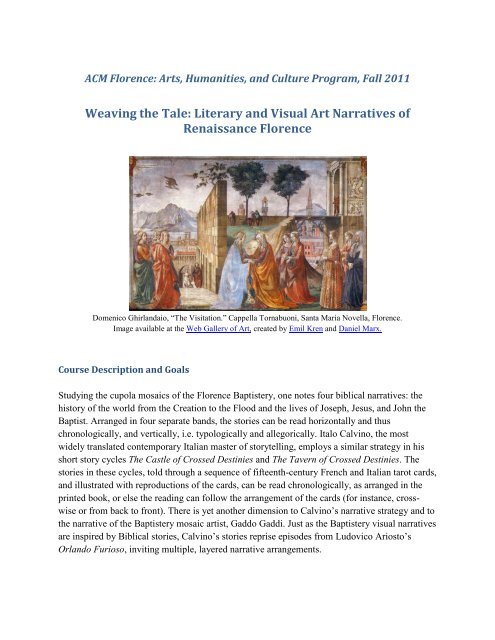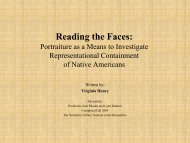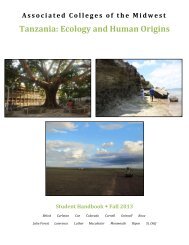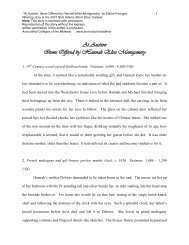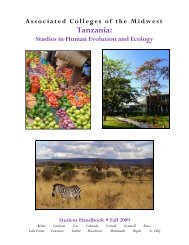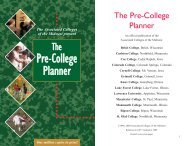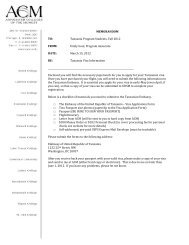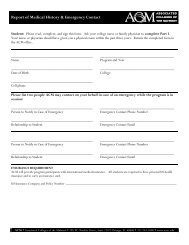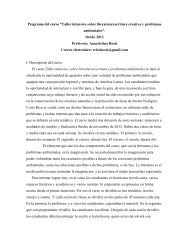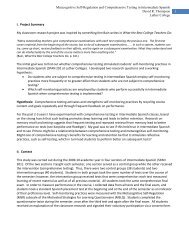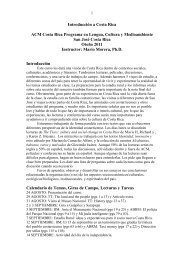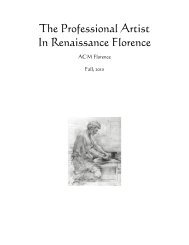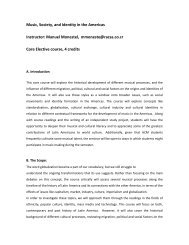Weaving the Tale: Literary and Visual Art Narratives of Renaissance ...
Weaving the Tale: Literary and Visual Art Narratives of Renaissance ...
Weaving the Tale: Literary and Visual Art Narratives of Renaissance ...
You also want an ePaper? Increase the reach of your titles
YUMPU automatically turns print PDFs into web optimized ePapers that Google loves.
ACM Florence: <strong>Art</strong>s, Humanities, <strong>and</strong> Culture Program, Fall 2011<br />
<strong>Weaving</strong> <strong>the</strong> <strong>Tale</strong>: <strong>Literary</strong> <strong>and</strong> <strong>Visual</strong> <strong>Art</strong> <strong>Narratives</strong> <strong>of</strong><br />
<strong>Renaissance</strong> Florence<br />
Domenico Ghirl<strong>and</strong>aio, “The Visitation.” Cappella Tornabuoni, Santa Maria Novella, Florence.<br />
Image available at <strong>the</strong> Web Gallery <strong>of</strong> <strong>Art</strong>, created by Emil Kren <strong>and</strong> Daniel Marx.<br />
Course Description <strong>and</strong> Goals<br />
Studying <strong>the</strong> cupola mosaics <strong>of</strong> <strong>the</strong> Florence Baptistery, one notes four biblical narratives: <strong>the</strong><br />
history <strong>of</strong> <strong>the</strong> world from <strong>the</strong> Creation to <strong>the</strong> Flood <strong>and</strong> <strong>the</strong> lives <strong>of</strong> Joseph, Jesus, <strong>and</strong> John <strong>the</strong><br />
Baptist. Arranged in four separate b<strong>and</strong>s, <strong>the</strong> stories can be read horizontally <strong>and</strong> thus<br />
chronologically, <strong>and</strong> vertically, i.e. typologically <strong>and</strong> allegorically. Italo Calvino, <strong>the</strong> most<br />
widely translated contemporary Italian master <strong>of</strong> storytelling, employs a similar strategy in his<br />
short story cycles The Castle <strong>of</strong> Crossed Destinies <strong>and</strong> The Tavern <strong>of</strong> Crossed Destinies. The<br />
stories in <strong>the</strong>se cycles, told through a sequence <strong>of</strong> fifteenth-century French <strong>and</strong> Italian tarot cards,<br />
<strong>and</strong> illustrated with reproductions <strong>of</strong> <strong>the</strong> cards, can be read chronologically, as arranged in <strong>the</strong><br />
printed book, or else <strong>the</strong> reading can follow <strong>the</strong> arrangement <strong>of</strong> <strong>the</strong> cards (for instance, crosswise<br />
or from back to front). There is yet ano<strong>the</strong>r dimension to Calvino’s narrative strategy <strong>and</strong> to<br />
<strong>the</strong> narrative <strong>of</strong> <strong>the</strong> Baptistery mosaic artist, Gaddo Gaddi. Just as <strong>the</strong> Baptistery visual narratives<br />
are inspired by Biblical stories, Calvino’s stories reprise episodes from Ludovico Ariosto’s<br />
Orl<strong>and</strong>o Furioso, inviting multiple, layered narrative arrangements.
Italian visual <strong>and</strong> language artists are especially fond <strong>of</strong> such narrative inter-weaving. Taking<br />
advantage <strong>of</strong> on-site explorations <strong>of</strong> room <strong>and</strong> furniture art in Florentine palazzos <strong>and</strong> <strong>of</strong> church<br />
art in Florence <strong>and</strong> Siena, we will analyze <strong>the</strong> narrative structures <strong>of</strong> art objects designed for<br />
daily consumption <strong>and</strong> reflection. We will study <strong>the</strong> interfaces <strong>of</strong> <strong>the</strong>se narrative structures with<br />
tales <strong>and</strong> tale cycles by authors from <strong>the</strong> Italian <strong>Renaissance</strong> or authors writing about <strong>the</strong> Italian<br />
<strong>Renaissance</strong>. The goal is to develop an underst<strong>and</strong>ing <strong>of</strong> <strong>the</strong> close, lived relationship between <strong>the</strong><br />
world <strong>of</strong> <strong>Renaissance</strong> Florentines <strong>and</strong> ancient or Christian history, <strong>of</strong> <strong>the</strong> porous boundaries<br />
between modernity <strong>and</strong> history, <strong>the</strong> secular <strong>and</strong> <strong>the</strong> sacred in <strong>the</strong> <strong>Renaissance</strong>. We will also pose<br />
<strong>the</strong> question about <strong>the</strong> state <strong>of</strong> <strong>the</strong>se boundaries today, based on <strong>the</strong> modern readings <strong>and</strong> your<br />
lived experience <strong>of</strong> present-day Italian culture.<br />
Texts (at <strong>the</strong> Paperback Exchange)<br />
Lucrezia Tornabuoni de’Medici, Sacred <strong>Narratives</strong>. University <strong>of</strong> Chicago Press, 2001 (SN).<br />
Giovanni Boccaccio, The Decameron. Oxford World Classics, 2008.<br />
Calvino, Italo. The Castle <strong>of</strong> Crossed Destinies. Harcourt, 1997 (CCD).<br />
Anna Banti, <strong>Art</strong>emisia. University <strong>of</strong> Nebraska Press, 1995.<br />
Short online readings linked to <strong>the</strong> syllabus.<br />
Course Requirements<br />
Attendance/ Participation (20%): In every venue, energetic listening (including note-taking<br />
<strong>and</strong> thoughtful engagement with o<strong>the</strong>rs’ ideas) <strong>and</strong> culturally sensitive-behavior are assumed. In<br />
addition, you are expected to attend all class meetings <strong>and</strong> site visits; abide by <strong>the</strong> 10<br />
Comm<strong>and</strong>ments <strong>of</strong> Study Abroad <strong>and</strong> honor <strong>the</strong> needs <strong>of</strong> <strong>the</strong> group; arrive at destinations on<br />
time; treat with politeness <strong>and</strong> unselfishness all peers, lecturers, <strong>and</strong> staff at <strong>the</strong> sites.<br />
A presentation (10%) on <strong>the</strong> nature <strong>and</strong> function <strong>of</strong> narrative techniques in a work <strong>of</strong> narrative<br />
visual art or in a literary work (excluding The Decameron).<br />
Brigata Assignment (25%): For each day <strong>of</strong> The Decameron you read, create a seating chart <strong>of</strong><br />
<strong>the</strong> storytellers, taking into account how <strong>the</strong>ir relationships are likely to affect who sits with<br />
whom, <strong>and</strong> how <strong>the</strong> stories told may affect <strong>the</strong> seating arrangement. You will also research one<br />
member <strong>of</strong> <strong>the</strong> brigata (to be assigned) to create a new literary portrait <strong>of</strong> <strong>the</strong> character. The<br />
portrait should include reflection on background, physical <strong>and</strong> psychological characteristics,<br />
symbolic value, preferred storytelling motifs, <strong>the</strong>mes, <strong>and</strong> techniques, <strong>and</strong> your storyteller’s<br />
reaction to <strong>the</strong> tales <strong>of</strong> <strong>the</strong> o<strong>the</strong>rs members <strong>of</strong> <strong>the</strong> brigata. The research part <strong>of</strong> <strong>the</strong> brigata<br />
assignment would be about 5-6 pages <strong>and</strong> must include a relevant visual component<br />
(photographs, drawings, collage, etc.)<br />
Final Project (30%): A drawing sequence/photo essay or a tale cycle adapting, appropriating, or<br />
critiquing one <strong>of</strong> <strong>the</strong> works studied in <strong>the</strong> class (8-10 pp.). If your presentation was on a work <strong>of</strong><br />
narrative visual art, you must compose a tale cycle; conversely, if you presented on a literary
work, you would have to develop a drawing sequence/photo essay. Hybrid art forms are<br />
encouraged. Each project must include an author’s or artist’s statement (1-2 pp) on <strong>the</strong> goals <strong>of</strong><br />
<strong>the</strong> work <strong>and</strong> its relationship to <strong>the</strong> source work(s).<br />
A final oral exam (15%), when you would introduce your creative project to <strong>the</strong> class <strong>and</strong> field<br />
questions about <strong>the</strong> narrative techniques you’ve used.<br />
Schedule<br />
Week 1<br />
1 st class: Introduction to <strong>the</strong> course: <strong>the</strong>mes, concepts, methodologies, assignments. Sign-up for<br />
presentations.<br />
2 nd class: Calvino, “The Castle <strong>of</strong> Crossed Destinies” (CCD).<br />
Week 2<br />
1 st class: Calvino, “The Tavern <strong>of</strong> Crossed Destinies” (CCD).<br />
2 nd class: Field trip to Sienna. Reading narrative public art: Amrogio Lorenzetti, Good <strong>and</strong> Bad<br />
Government in Palazzo Pubblico. Reading church art narratives at <strong>the</strong> Pinacoteca Nazionale di<br />
Siena. Ca<strong>the</strong>rine <strong>of</strong> Siena’s relics in San Dominico.<br />
Week 3:<br />
1 st class: Boccaccio, The Decameron. First Day (under <strong>the</strong> rule <strong>of</strong> Pampinea): The Author’s<br />
Introduction, Novelle 1-4. The Brigata <strong>and</strong> <strong>the</strong> Frame. Numerology <strong>and</strong> narrative structure.<br />
Brigata chart due.<br />
2 nd class: The Decameron, Second Day (under <strong>the</strong> rule <strong>of</strong> Filomena): Novelle 4 (L<strong>and</strong>olfo<br />
Rufolo), 5 (Andreuccio's night), <strong>and</strong> 7 (Alatiel's silence). The Wheel <strong>of</strong> Fortune. Fortuna as<br />
topic. Pasolini's Dream (clip on You Tube from his 1971 film Decameron). Brigata chart due.<br />
Week 4: Break (Buon viaggio!).<br />
Week 5<br />
1 st class: The Decameron, Third Day (under <strong>the</strong> rule <strong>of</strong> Neifile). Novelle 1 (Masetto's heaven), 8<br />
(Ferondo), 10: Alibech's hell. The Garden <strong>of</strong> Desire. Amore as a topic. Theme <strong>of</strong> Nature as<br />
Morality. Sexual desire <strong>and</strong> narrative seduction. Brigata chart due.<br />
2 nd class: The Decameron, Fourth Day (under <strong>the</strong> rule <strong>of</strong> Filostrato). Novelle 1 (Tancredi <strong>and</strong><br />
Ghismonda), 2 (frate Alberto), 5 (Lisabetta <strong>and</strong> her bro<strong>the</strong>rs). Motif <strong>of</strong> love relics: Ghismonda's<br />
heart <strong>and</strong> Lisabetta's head. Disguising gender: Lisetta's angel. Brigata chart due.<br />
Week 6<br />
1 st class: The Decameron, Fifth Day (under <strong>the</strong> rule <strong>of</strong> Fiammetta). Novelle 1 (Cimone <strong>and</strong><br />
Iphigenia), 4 (Caterina's Nightingale), 9 (Federigo degli Alberighi's Falcon). Cassoni visual<br />
narratives (Nastagio <strong>and</strong> Botticelli). Brigata chart due.
2 nd class: The Decameron, Sixth Day (under <strong>the</strong> rule <strong>of</strong> Elissa): Novelle 3 (Monna Nonna de'<br />
Pulci) <strong>and</strong> 7 (Madonna Filippa's transgression). Seventh Day (under <strong>the</strong> rule <strong>of</strong> Dioneo): Novelle<br />
2 (Peronella) <strong>and</strong> 5 (a jealous husb<strong>and</strong>). Who rules <strong>the</strong> domestic space? Class meets at Palazzo<br />
Davanzati. Brigata chart due.<br />
Week 7<br />
1 st class: The Decameron, Ninth Day (under <strong>the</strong> rule <strong>of</strong> Emilia). Novelle 1 (Madonna Francesca),<br />
2 (an Abbess), 10 (donno Gianni <strong>and</strong> compar Pietro). Brigata chart due.<br />
2 nd class: The Decameron, Tenth Day. Novelle 10 (<strong>the</strong> Marquis <strong>of</strong> Saluzzo <strong>and</strong> patient Griselda)<br />
<strong>and</strong> The Author's Epilogue. Griselda cassone. Complete Brigata assignment due (all charts<br />
<strong>and</strong> literary portrait).<br />
Week 8<br />
1 st class: Book <strong>of</strong> Es<strong>the</strong>r (Hebrew Bible), Lucrezia Tornabuoni de’Medici, “The Story <strong>of</strong> Queen<br />
Es<strong>the</strong>r” (SN). Visit to <strong>the</strong> Sala dei Cinquecento in Palazzo Vecchio (with a stop, in anticipation<br />
<strong>of</strong> <strong>the</strong> next reading assignment, at Donatello’s original Judith <strong>and</strong> Hol<strong>of</strong>ernes in <strong>the</strong> Sala dei<br />
Gigli), <strong>the</strong>n on to <strong>the</strong> Boboli Gardens.<br />
2 nd class: Read <strong>the</strong> Book <strong>of</strong> Judith. Class meets in front <strong>of</strong> <strong>the</strong> Baptistery: Judith <strong>and</strong> Hol<strong>of</strong>ernes<br />
on Ghiberti’s doors; <strong>the</strong>n on to <strong>the</strong> Uffizi: Botticelli’s, Mantegna’s, <strong>and</strong> Gentileschi’s Judith<br />
narratives. Due: proposal for final project (1-2 paragraphs on <strong>the</strong> topic <strong>and</strong> medium, structural<br />
breakdown, ideas for links, plus a short bibliography).<br />
.<br />
Week 9<br />
1 st class: Lucrezia Tornabuoni de’Medici, “The Story <strong>of</strong> Judith, Hebrew Widow” (SN).<br />
2 nd class: Lucrezia Tornabuoni de’Medici, “The Story <strong>of</strong> Devout Susanna,” along with<br />
Gentileschi, Veronese, <strong>and</strong> Tintoretto’s visual narratives. Class (hopefully) ends with a visit to<br />
<strong>the</strong> Biblioteca Nazionale Centrale di Firenze to view Tornabuoni’s illuminated manuscript.<br />
Week 10<br />
1 st class: Banti, <strong>Art</strong>emisia. Class in <strong>the</strong> Boboli gardens (wea<strong>the</strong>r permitting).<br />
2 nd class: Banti, <strong>Art</strong>emisia. Class (hopefully) at Banti’s house, <strong>the</strong> Fondazione Di Studi Di Storia<br />
Dell'<strong>Art</strong>e Roberto Longhi.<br />
Week 11<br />
1 st class: Group workshops <strong>of</strong> final projects.<br />
2 nd class: Oral exam on your visual, art, or mixed-media narrative, <strong>and</strong> festive finale. Turn<br />
in your final project.<br />
Important note: This syllabus is very much a work in progress <strong>and</strong> will be finalized at <strong>the</strong> start<br />
<strong>of</strong> <strong>the</strong> fall 2011 semester. Some <strong>of</strong> <strong>the</strong> class visits will be arranged in conjunction with o<strong>the</strong>r<br />
ACM Florence courses.


